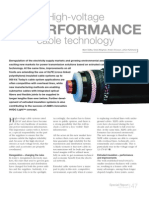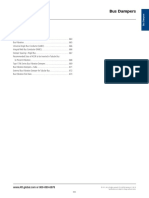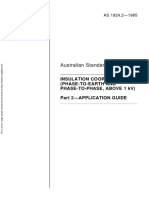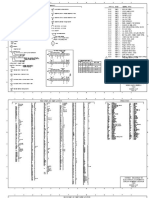Water Blocking
Water Blocking
Uploaded by
ramukolakiCopyright:
Available Formats
Water Blocking
Water Blocking
Uploaded by
ramukolakiOriginal Description:
Copyright
Available Formats
Share this document
Did you find this document useful?
Is this content inappropriate?
Copyright:
Available Formats
Water Blocking
Water Blocking
Uploaded by
ramukolakiCopyright:
Available Formats
1a
WATER BLOCKED MV XLPE CABLE
Testing of water
blocked cables
1b
WATER BLOCKED MV XLPE CABLE
Introduction
1. Introduction
2. Why Water Block Cables?
3. How to Water Block Cables
4. Proving Water Blocking
5. Water Penetration Tests
6. Aspects of a Water Blocked Cable Design
7. Impact of Water Blocking on Lugs and Ferrules
8. Aberdare's Test Rig
2.1
WATER BLOCKED MV XLPE CABLE
Why Water Block Cables?
Water + Any conductive parts
This conducts electricity, causing
Safe surfaces to become live and dangerous.
Instead of insulating, insulators conduct electricity.
In PILC electrical trees will form within the insulation.
Conductive path between phases or from phase to earth =
Remedies
Ensure that cables are always dry inside.
Maintain good insulation radials.
At cable ends keep insulation surfaces smooth.
Ensure insulation and sheathing is free of holes!
2.2
WATER BLOCKED MV XLPE CABLE
Why Water Block Cables?
Water + Electrical stress
This will attack ANY polymer, causing
WATER TREES.
A water tree is a regions of reduced insulation strength.
This is the ONLY known ageing chemical process for XLPE.
Eventually a water tree will cause an electrical tree, and
Remedies
Exclude all impurities.
Ensure that the HUMIDITY within the cable is less than 65%.
2.3
WATER BLOCKED MV XLPE CABLE
Why Water Block Cables?
Water + Oxidizing agents
Oxidizing agents attack metals, causing
Armour to corrode, leaving the cable unprotected and unearthed.
Screens to be interrupted, leading to failure.
Ci
Vp
(Insulation)
Vs
Cs
(Sheath)
Example: On A 300 mm 11 kV single core unarmoured with an interrupted
screen, the screen voltage will be 2 kV. This will puncture the sheath, allowing
water access to the screen.
Tracking will take place along the outer semiconcuctor.
The cable will sizzle for a few minute to a few days, then
3.1
WATER BLOCKED MV XLPE CABLE
How to Water Block Cables:
Radial water blocking
Generalized
cable:
Outer sheath
Metallic sheath
Insulation
Conductor
Radially water blocked below the impervious layer.
Use polyethylene for the impervious layer.
Use metal for the impervious layer.
Use both.
3.2
WATER BLOCKED MV XLPE CABLE
How to Water Block Cables:
Longitudinal water blocking
Generalized
cable:
Outer sheath
Metallic sheath
Conductor
Insulation
Block longitudinal water migration by layer.
Water swellable powders, yarns or tapes.
Bitumen.
Unvulcanized rubber.
Solid conductor.
4.3
WATER BLOCKED MV XLPE CABLE
Proving Water Blocking:
Water penetration test
Defined in SANS 1339, which refers to IEC 60502-2, with an amendment.
Includes 10 heat cycles, each lasting 8 hours.
Frequently a poor design will fail within minutes
5.1
WATER BLOCKED MV XLPE CABLE
Water Penetration Tests:
Standard tests
Step
IEC 60502-2
SANS 60840
IEC 62067
SANS 1339
MV XLPE
HV XLPE
EHV XLPE
MV XLPE
Initial sample size
6m
6m
8m
6m
Condition
Sample size
Bend test
3m
Bend test
6m
Bend test
8m
Bend test
3m
Stripped ring
50 mm
50 mm
50 mm
50 mm
Water head
1,0 m
1,0 m
1,0 m
1,0 m
Filling time
5 minutes
5 minutes
5 minutes
5 minutes
Standing time
Heat cycles
24 hours
10
24 hours
10
24 hours
10
24 hours
10
Cycle duration
8 hours
24 hours
24 hours
8 hours
Heating duration
5 hours
8 hours
8 hours
5 hours
Hold time
Cooling time
2 hours
3 hours
2 hours
16 hours
2 hours
16 hours
2 hours
3 hours
Conductor temp (min)
95 C
95 C
95 C
95 C
Conductor temp (max)
< 100 C
< boiling point
< 100 C
< boiling point
Pass criterion
No leak
No leak
No leak
No leak
6.1
WATER BLOCKED MV XLPE CABLE
Aspects of a Water Blocked Cable Design:
Techniques
To water block the complete cable it is imperative that all material interfaces
are either bonded or have water block material between them.
Each stage of the design is analysed and all interfaces water blocked.
Where electrical contact is required semi-conducting materials are used.
6.2a
WATER BLOCKED MV XLPE CABLE
Aspects of a Water Blocked Cable Design:
Materials
Tapes and Yarns containing Polyacrylate water swellable material.
Tapes can be either semiconducting or non-semiconducting.
Yarns are available in different diameters.
Bitumen is often used to water block wire armouring and also provides
corrosion resistance
6.2b
WATER BLOCKED MV XLPE CABLE
Aspects of a Water Blocked Cable Design:
Materials
Requirements for water blocking materials:
Short term stability
Long term stability
Repeatability of water blocking action
Compatibility between cable materials
6.2c
WATER BLOCKED MV XLPE CABLE
Aspects of a Water Blocked Cable Design:
Materials
Water Swellable tapes
Performance of superabsorbent materials:
Swell Height
Swell speed
6.2d
WATER BLOCKED MV XLPE CABLE
Aspects of a Water Blocked Cable Design:
Materials
Swelling of Superabsorbent materials
6.3a
WATER BLOCKED MV XLPE CABLE
Aspects of a Water Blocked Cable Design:
Conductors
Water blocking of conductors is achieved
using a swellable yarn in the centre and
swellable tapes over each layer of
wires.
Aberdare has completed type tests with
this design.
6.3b
WATER BLOCKED MV XLPE CABLE
Aspects of a Water Blocked Cable Design:
Conductors
Wetting water blocked conductor.
6.4
WATER BLOCKED MV XLPE CABLE
Aspects of a Water Blocked Cable Design:
Copper Tapes
Water blocking of copper tapes is achieved by applying a semi-conducting
swellable tape under the copper tape, which provides electrical contact
between the core screen and copper tape.
Over the copper tape could be water blocked with swellable yarns applied as
a filler during lay up, if required.
6.6
WATER BLOCKED MV XLPE CABLE
Aspects of a Water Blocked Cable Design:
Armour
Water blocking of the armour is achieved by flooding the armour with bitumen
which seals the interstices between the armour wires and enhances the
corrosion resistance of the armour wires.
6.7
WATER BLOCKED MV XLPE CABLE
Aspects of a Water Blocked Cable Design:
Other issues
Special Manufacture
Lead time for materials
Cost increase
7.1
WATER BLOCKED MV XLPE CABLE
Impact of Water Blocking on Lugs & Ferrules:
Concern
Water blocking tape between the layers of a stranded conductor prevents
current from flowing freely between layers.
Over a long length of conductor this is no problem because there is no useful
radial component to current.
It is a concern in the case of lugs and ferrules where there is a significant
radial component to current.
In the steady state the heat sink effect of metals in contact will prevent
dangerous temperatures.
In the transient adiabatic situation short duration high temperatures could
occur.
7.2
WATER BLOCKED MV XLPE CABLE
Impact of Water Blocking on Lugs & Ferrules:
Test method
Comparative testing is carried out between bare conductors without water
blocking components and bare conductors with water blocking components.
Each sample is terminated using lugs, and jointed mid-span with a connector
(ferrule).
The temperatures in the connector, adjacent to the contact between conductor
and connector, as well as of the conductor away from the connector, is
measured.
The conductors are loaded to specific conductor temperatures and the
connector temperatures are measured.
Any increase in the connector temperature for the same conductor
temperature indicates that there is some resistance to radial current at the
connector.
7.4
WATER BLOCKED MV XLPE CABLE
Impact of Water Blocking on Lugs & Ferrules:
Conclusion
Early indications are that there may be a slight increase in resistance to radial
current.
The likelihood of this causing damage to the insulation is low during a fault,
because no insulation should be present at hot spot.
Never-the-less water blocking materials should be removed from conductors
inserted into connectors and lugs, until proven that this is not necessary.
8.4
WATER BLOCKED MV XLPE CABLE
Aberdares Test Rig
Thank you
You might also like
- 6th Central Pay Commission Salary CalculatorDocument15 pages6th Central Pay Commission Salary Calculatorrakhonde100% (436)
- 446Document67 pages446binodeNo ratings yet
- Use of Aluminum Conductors in Submarine Power CablesDocument6 pagesUse of Aluminum Conductors in Submarine Power CablesThai AnhNo ratings yet
- Prysmian HV Cables 2007 PDFDocument20 pagesPrysmian HV Cables 2007 PDFdsanmi100% (2)
- Cable Termination Failure ReasonsDocument3 pagesCable Termination Failure ReasonsImran Ahmed100% (2)
- Specialty LDPE PolymersDocument6 pagesSpecialty LDPE Polymersmember1000No ratings yet
- Failure Modes of Outdoor InsulatorsDocument4 pagesFailure Modes of Outdoor InsulatorszerferuzNo ratings yet
- Underground Power Cables Catalogue 03-2010Document48 pagesUnderground Power Cables Catalogue 03-2010Edgar Sierra Rodriguez100% (1)
- Vc9808+ ManualDocument3 pagesVc9808+ ManualJose Dario Soto ParisNo ratings yet
- OEC 7700 CalibrationDocument7 pagesOEC 7700 CalibrationWade Dyer100% (5)
- Water Blocking in MV XLPE Cables - EE PublishersDocument5 pagesWater Blocking in MV XLPE Cables - EE PublisherscarlremNo ratings yet
- The Norned HVDC Cable LinkDocument6 pagesThe Norned HVDC Cable LinkardiwilagagunNo ratings yet
- Water Tree Cable JointsDocument151 pagesWater Tree Cable JointsSellappan MuthusamyNo ratings yet
- Aged Acsr Conductors Testing Procedures For Conductors and LinDocument7 pagesAged Acsr Conductors Testing Procedures For Conductors and LinpabloNo ratings yet
- A Theoretical Model For Corrosion Assessment in Overhead Line ConductorsDocument6 pagesA Theoretical Model For Corrosion Assessment in Overhead Line Conductorsdeathjester1No ratings yet
- PHD Thesis 13.11.2018 P. CicheckiDocument225 pagesPHD Thesis 13.11.2018 P. CicheckiCésar Díaz LiberonaNo ratings yet
- CIGRE-216 Assessment Midspan Joints TransmissionDocument10 pagesCIGRE-216 Assessment Midspan Joints TransmissionAdrian PramantaNo ratings yet
- Dow TR Xlpe CompoundDocument4 pagesDow TR Xlpe Compoundraghav100% (1)
- Introduction HVDCDocument23 pagesIntroduction HVDCmodanto100% (1)
- Xlpe Vs EprDocument24 pagesXlpe Vs EprazizNo ratings yet
- Section Four - Medium Voltage Tr-Xlpe Cables: Explanatory Information 2-13Document56 pagesSection Four - Medium Voltage Tr-Xlpe Cables: Explanatory Information 2-13Terex14253No ratings yet
- Cable Fault LocationDocument29 pagesCable Fault Locationmahmoud MotamediNo ratings yet
- Ls Ehv Cable System: 66 500kV XLPE Cable & AccessoriesDocument26 pagesLs Ehv Cable System: 66 500kV XLPE Cable & AccessoriesreggenziNo ratings yet
- Calculation of Induced Sheath Voltage For Transposed and Untransposed Cable ConductorsDocument6 pagesCalculation of Induced Sheath Voltage For Transposed and Untransposed Cable ConductorsPradeep PooNoorNo ratings yet
- Tricks For Cable Accessories InstallationDocument30 pagesTricks For Cable Accessories InstallationcxfuentesNo ratings yet
- High Voltage - 2020 - Su - Electrical Tree Degradation in High Voltage Cable Insulation Progress and ChallengesDocument12 pagesHigh Voltage - 2020 - Su - Electrical Tree Degradation in High Voltage Cable Insulation Progress and ChallengesLuiz KowalskiNo ratings yet
- 240mm2 Submarine CableDocument1 page240mm2 Submarine Cableanon_923649310No ratings yet
- Partial Discharge TestingDocument349 pagesPartial Discharge Testinghungphuc2010No ratings yet
- 3A - Dielectric MaterialsDocument75 pages3A - Dielectric MaterialsrailrajNo ratings yet
- Water Tree B54Document28 pagesWater Tree B54constellanaNo ratings yet
- Cable Termination I-FundamentalDocument35 pagesCable Termination I-Fundamentalသူ ရိန်No ratings yet
- Prysmian Offshore PDFDocument88 pagesPrysmian Offshore PDFErstendrain Eng100% (1)
- Link Boxes in Ehv CablesDocument7 pagesLink Boxes in Ehv CablesRavi Kumar100% (1)
- OFS CAB 101 R2 220 KV and 400kV Underground CableDocument94 pagesOFS CAB 101 R2 220 KV and 400kV Underground Cablethiago.licio.engNo ratings yet
- Cable Joint Heat DissipationDocument17 pagesCable Joint Heat DissipationRamesh Vr100% (1)
- Kema Cables PDFDocument1 pageKema Cables PDFMahmoud AbuziadNo ratings yet
- HV DC PrysmianDocument32 pagesHV DC PrysmianFiras AtwanNo ratings yet
- 400 KV Underground Cables in Rural AreasDocument9 pages400 KV Underground Cables in Rural Areassong0603No ratings yet
- 33kV Jointing Manual Section 4Document84 pages33kV Jointing Manual Section 4Egbodor PeterNo ratings yet
- Handling Installation Rev 21Document23 pagesHandling Installation Rev 21yildirimonlineNo ratings yet
- Jic07 A21 PDFDocument11 pagesJic07 A21 PDFccrrzzNo ratings yet
- Voltages Induced in Sheaths and Armour of Single Core CablesDocument2 pagesVoltages Induced in Sheaths and Armour of Single Core CablesHameedNo ratings yet
- Effectiveness of Impressed Current Cathodic Protection System On Underground Steel Engen Refinery Transfer Lines SystemDocument105 pagesEffectiveness of Impressed Current Cathodic Protection System On Underground Steel Engen Refinery Transfer Lines Systemsrglwl89No ratings yet
- Pre-Commissioning Tests For Power Cable R3Document18 pagesPre-Commissioning Tests For Power Cable R3Fahimuddin QureshiNo ratings yet
- HV Catalogue 0902Document64 pagesHV Catalogue 0902Irving VitaliNo ratings yet
- Failure of Submarine Cables Used in High-Voltage Power Transmission (DDocument16 pagesFailure of Submarine Cables Used in High-Voltage Power Transmission (DTrầnHữuHòa100% (1)
- SF6 Partial DischargeDocument4 pagesSF6 Partial DischargeCesar VenturoNo ratings yet
- Thermally Upgraded PaperDocument5 pagesThermally Upgraded Paperamulya00428No ratings yet
- Robust High Voltage Cable Joint DesignDocument5 pagesRobust High Voltage Cable Joint DesignsubhankarNo ratings yet
- 27 HV XLPErformance Cable TechnologyDocument6 pages27 HV XLPErformance Cable TechnologyRanaSinhaNo ratings yet
- Insulator Shed ProfileDocument4 pagesInsulator Shed Profilebharat_ravulapalliNo ratings yet
- PA CIGRE-2014 A Deeper Insight Into Fault Location On Long Submarine Power Cables ENDocument10 pagesPA CIGRE-2014 A Deeper Insight Into Fault Location On Long Submarine Power Cables ENUsman AliNo ratings yet
- Breakdown in Solid Dielectrics: S.Sundara Mahalingam AP/EEE, MSEC SivakasiDocument36 pagesBreakdown in Solid Dielectrics: S.Sundara Mahalingam AP/EEE, MSEC SivakasiGooge ReviewerNo ratings yet
- Tracking in InsulatorsDocument6 pagesTracking in InsulatorsGaurav kumarNo ratings yet
- Electric Field Distribution in Glass and Porcelain Pin InsulatorDocument5 pagesElectric Field Distribution in Glass and Porcelain Pin Insulatoremmanuel799No ratings yet
- TR Value Testing PDFDocument11 pagesTR Value Testing PDFKingsley InbasinghNo ratings yet
- Bitumen Use in Electrical InsulationDocument6 pagesBitumen Use in Electrical Insulationsamar209No ratings yet
- Cable Sheaths Overvoltage Protection, ABBDocument14 pagesCable Sheaths Overvoltage Protection, ABBMuhammad HamzaNo ratings yet
- Recommendations For Testing DC Extruded Cable Systems For Power Transmission at A Rated Voltage Up To 500 KVDocument36 pagesRecommendations For Testing DC Extruded Cable Systems For Power Transmission at A Rated Voltage Up To 500 KVromany allamNo ratings yet
- Cable Termination - ABB PDFDocument2 pagesCable Termination - ABB PDFrasheed313No ratings yet
- 66kV and 132kV HV Catalogue ENSDocument15 pages66kV and 132kV HV Catalogue ENSCristi GrosuNo ratings yet
- Basic Math For Cable TerminationDocument17 pagesBasic Math For Cable TerminationAbraham JyothimonNo ratings yet
- Ingress Protection RatingsDocument1 pageIngress Protection RatingsramukolakiNo ratings yet
- Zetty Catalogue 121Document1 pageZetty Catalogue 121ramukolakiNo ratings yet
- Flexicurity in DenmarkDocument12 pagesFlexicurity in Denmarkramukolaki100% (1)
- BMS For Li-IonDocument26 pagesBMS For Li-IonramukolakiNo ratings yet
- 2017 11 Economics Sample Paper 02 Ans Ot8ebDocument5 pages2017 11 Economics Sample Paper 02 Ans Ot8ebramukolakiNo ratings yet
- Sample Paper-02 (2016-17) Economics Class - XI Time Allowed: 3 Hours Maximum Marks: 90 General InstructionsDocument2 pagesSample Paper-02 (2016-17) Economics Class - XI Time Allowed: 3 Hours Maximum Marks: 90 General InstructionsramukolakiNo ratings yet
- Sample Paper-05 (2016-17) Economics Class - XI Time Allowed: 3 Hours Maximum Marks: 90 General InstructionsDocument2 pagesSample Paper-05 (2016-17) Economics Class - XI Time Allowed: 3 Hours Maximum Marks: 90 General InstructionsramukolakiNo ratings yet
- Li Ion SafetyDocument3 pagesLi Ion SafetyramukolakiNo ratings yet
- Sample Paper-01 (2016-17) Economics Class - XI Time Allowed: 3 Hours Maximum Marks: 90 General InstructionsDocument2 pagesSample Paper-01 (2016-17) Economics Class - XI Time Allowed: 3 Hours Maximum Marks: 90 General InstructionsramukolakiNo ratings yet
- Hsee 2011 QPDocument26 pagesHsee 2011 QPMota Chashma0% (1)
- Ecoult UltraBattery White Paper General VersionDocument20 pagesEcoult UltraBattery White Paper General VersionramukolakiNo ratings yet
- ESS 2012 Peer Review - Life Cycle Testing and Evaluation of Energy Storage Devices - Summer Ferreira, SNLDocument16 pagesESS 2012 Peer Review - Life Cycle Testing and Evaluation of Energy Storage Devices - Summer Ferreira, SNLramukolakiNo ratings yet
- General or Blanket Permission To Travel by Private Airlines - 0Document1 pageGeneral or Blanket Permission To Travel by Private Airlines - 0ramukolakiNo ratings yet
- 2934 WSG Win8 ShortcutKeys QuickReferenceGuide ExternalDocument5 pages2934 WSG Win8 ShortcutKeys QuickReferenceGuide ExternalramukolakiNo ratings yet
- Modified DDQ by Mov Dte 31 Mar 2014Document72 pagesModified DDQ by Mov Dte 31 Mar 2014ramukolakiNo ratings yet
- Electron Beam Curing of CompositesDocument9 pagesElectron Beam Curing of CompositesramukolakiNo ratings yet
- Electron Beam Curing of CompositesDocument9 pagesElectron Beam Curing of CompositesramukolakiNo ratings yet
- Agri Plas GreenhouseDocument8 pagesAgri Plas GreenhouseramukolakiNo ratings yet
- AFL Substation Bus DampersDocument12 pagesAFL Substation Bus DampersDejanNo ratings yet
- (PDF) Fundamentals of Network Analysis and SynthesisDocument3 pages(PDF) Fundamentals of Network Analysis and SynthesisKomal TiwariNo ratings yet
- AOD404 N-Channel Enhancement Mode Field Effect Transistor: Features General DescriptionDocument6 pagesAOD404 N-Channel Enhancement Mode Field Effect Transistor: Features General Descriptiondreyes3773No ratings yet
- 05.02-05 - Installation Guide For HVDC 380VDocument13 pages05.02-05 - Installation Guide For HVDC 380VAlexe VictorNo ratings yet
- I-Trigue 2.1 3300 QSGDocument2 pagesI-Trigue 2.1 3300 QSGhfloresNo ratings yet
- Abb BessDocument12 pagesAbb Bessmher.bakalianNo ratings yet
- Explosion Protection TechniquesDocument30 pagesExplosion Protection TechniquesAhmad JoiyaNo ratings yet
- Weidmuller HazLoc Catalog 2014 LIT1315EDocument12 pagesWeidmuller HazLoc Catalog 2014 LIT1315Evaseem shaikNo ratings yet
- EIM MODULE 2 Quarter2Document25 pagesEIM MODULE 2 Quarter2Aldrin Santos90% (10)
- Dynamic VAR Compensation Using Static VAR CompensatorDocument9 pagesDynamic VAR Compensation Using Static VAR CompensatorIJSTENo ratings yet
- FM RADIO TRANSMITTER (Report)Document3 pagesFM RADIO TRANSMITTER (Report)Teja Reddy100% (2)
- AP3041 Oscilador TV Haier 50yca PDFDocument14 pagesAP3041 Oscilador TV Haier 50yca PDFmaroNo ratings yet
- Group 2 Ip Final PaperDocument18 pagesGroup 2 Ip Final Paperapi-654318841No ratings yet
- Tri-Rated Rev005Document2 pagesTri-Rated Rev005Jean Pierre Goossens100% (1)
- Kew 4140 PDFDocument2 pagesKew 4140 PDFGermanilloZetaNo ratings yet
- As 1824.2-1985 Insulation Coordination (Phase-To-earth and Phase-To-phase Above 1 KV) Application GuideDocument8 pagesAs 1824.2-1985 Insulation Coordination (Phase-To-earth and Phase-To-phase Above 1 KV) Application GuideSAI Global - APACNo ratings yet
- Electric Charges and FieldDocument5 pagesElectric Charges and FieldEunbyeolNo ratings yet
- Innovair EIN Elite Mini Split Troubleshooting ManualDocument44 pagesInnovair EIN Elite Mini Split Troubleshooting ManualfrantsNo ratings yet
- sczf1 SCR ManualDocument24 pagessczf1 SCR ManualGene HarvilleNo ratings yet
- Switchgear Brochure ScreenDocument12 pagesSwitchgear Brochure ScreennetlabindiaNo ratings yet
- WEG Motorized Brush Lifting System 655 Brochure English PDFDocument4 pagesWEG Motorized Brush Lifting System 655 Brochure English PDFidontlikeebooks100% (1)
- 48v 250w High Speed Hub Motor Kit Alter Lithium Phosphate Battery Lithium Charger Hub Full SetDocument22 pages48v 250w High Speed Hub Motor Kit Alter Lithium Phosphate Battery Lithium Charger Hub Full SetStudyNo ratings yet
- Webasto Thermo 50 Operating InstructionsDocument5 pagesWebasto Thermo 50 Operating InstructionsDavid ButlerNo ratings yet
- Harmonic Inductive Gain OverviewDocument1 pageHarmonic Inductive Gain OverviewSheila KorirNo ratings yet
- Harmonic Quality in Naval ShipsDocument6 pagesHarmonic Quality in Naval Shipstkdrt2166No ratings yet
- Eia 232 422 486Document40 pagesEia 232 422 486Supriya DessaiNo ratings yet
- Junction Field Effect Transistor or JFET TutorialDocument13 pagesJunction Field Effect Transistor or JFET TutorialashmigeorgeNo ratings yet
- 730E ElectricoDocument31 pages730E ElectricoVictor Lemus RojasNo ratings yet











































































































